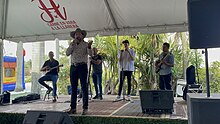Joropo
| Joropo | |
|---|---|
 | |
| Stylistic origins | Arabic melismatic music, cante jondo, Spanish folklore |
| Cultural origins | Colombia |
| Typical instruments | Harp, cuatro venezolano, capachos or maracas, bandola, mandolin, bandolin, tiple, bandolón, guitar and guacharaca |
| Subgenres | |
| Romantic Joropo, Creole Joropo, Alternative Joropo | |
The joropo, better known as Música Llanera, is a
In 1882 it became Venezuela's national dance and music. Formerly, the Spanish word joropo meant "a party", but now it has come to mean a type of music and dance that identifies Venezuelans. In the 18th century, the llaneros started using the word joropo instead of fandango, which was used at the time for party and dance.
Venezuela
Tuyero
Central joropo (Spanish: joropo central) is also known as tuyero ("Tuyan"), joropo tuyero ("Tuyan joropo") or golpe tuyero ("Tuyan beat").[3]
Characteristic of the central states of Venezuela, like
The most characteristic of tuyero folklore piece, "The Tuyero Revolt" ("Revuelta tuyera"), consists of four sections: the exhibition (passage), development (yaguaso and guabina), the instrumental coda ("Marisela") and an end known as "the call monkey". The most famous tuyero passages are "El ermitaño" of Mario Diaz, "Amanecer tuyero" of Cipriano Moreno and Pablo Hidalgo, and "El gato enmochilado" of Fulgencio Aquino.
Eastern joropo
Characteristic of the northeastern region of Venezuela, specifically of
4 rhythm that is repeated two or more times; the second section or "chorus" is an improvised melody over a fixed harmonic rhythm cycle is 6
8. Note that in the eastern joropo, cuatro and maracas are executed in a much freer and more complex than in the rest of Venezuelans joropos way. Likewise, it is important to mention that the musical tradition of the eastern region of Venezuela has many other forms besides the eastern joropo.
Guayanés joropo
Joropo in the Venezuelan region of Guayana is the product of the interaction of llaneros and eastern Bolivar state, specifically in Ciudad Bolívar. It is executed with the Guayanese mandolin (eight metal strings), cuatro and maracas. The Seis Guayanés, the Josa and Rompeluto highlight among the most famous Guyanese joropos.
Golpe tocuyano or larense joropo
Hailing from the West Central region of Venezuela, mainly the states of Lara, Portuguesa (Sierra de Portuguesa) and Yaracuy. Played by a variety of stringed instruments (Four, Middle Five, Five and Six) together with Tambora and maracas produce a very particular and unique sound among other Venezuelan joropos. Celebrity tocuyanos hits are "Amalia Rosa", "Montilla", "Gavilan Tocuyano" and "Ah mundo! Barquisimeto", "Los Dos Gavilanes", "The Fright", "Pajarillo Tocuyano", "Garrote Encabullao", "Fire Fire", among many others. Dancing in the number of members is six couples.
Quirpa
Legend says that this type of joropo is named after Jose Antonio Oquendo, who was nicknamed "Quirpa" . Burrowing harpist of the late nineteenth century who died of a stab wound . The quirpa uses ternary and tertiary bars and sometimes combined, with shifts of rhythm and musical accents .
Joropo llanero

Until the mid-twentieth century, and with regard to the region of the plains of Venezuela, the joropo word referring to a social event almost a fair- for a period that could vary from a few hours and even a full week.
Dancing
The Joropo folk dance in Venezuela is seen as a rich musical expression. This dance is greatly cherished and seen as the national dance and symbol of the nation. Joropo's known as an umbrella genre that implements a variety in dance and vocals. Music is a substantive part of Joropo, and till this day, Venezuela is not in opposition to its popularity. Joropo is filled with artists who move between academic and popular music.[5] It is adopted and still uses the hand turn, the movement of the feet, and waltz turns. First, the partners dance a type of waltz holding each other tightly. Then they stand facing each other and make small steps forward and backward as if sweeping the floor. Lastly they hold each other's arms, and the woman does sweeping steps while the man stomps his feet along with the music's rhythm. Joropo is a genre, emerged to represent Venezuela's identity because of its popularity and by how much it was enjoyed across many regions in the nation.[6]
The Joropo is played with the
The singer and the harp or bandola may perform the main melody while a cuatro performs the accompaniment, adding its characteristic rhythmic, sharp percussive effect. The cuatro and the bandola are four-stringed instruments which are descendants of the Spanish guitar. The only real percussion instruments used are the maracas. Besides the genre and dance, the name joropo also means the performance, the event or occasion of performance.
Evolution and more refined forms
In modern times, several other instruments have been added to playing various parts in joropo performances, for instance, guitar, flute, clarinet, piano, and up to a complete symphony orchestra playing joropo arrangements.[citation needed]
See also
Sources
- Dydynski, Krzysztof (2004). Lonely Planet Venezuela. ISBN 1-74104-197-X.
References
- ^ Shepherd, John and Horn, David. Bloomsbury Encyclopedia of Popular Music of the World, Volume 9: Genres: Caribbean and Latin, pp. 400–402 (Bloomsbury Publishing 2014).
- ISBN 9789800102541.
- ISBN 978-1-60974-659-9.
arpa tuyera (al estilo del joropo tuyero) [Tuyan harp (in the style of a Tuyan joropo)] […] a particular kind of joropo […] called golpe tuyero.
- ^ a b Reese, Allison (2021). "Venezuelan Virtuoso". Harp Column. 30 (1): 18–23.
- ^ The Joropo in Venezuela’s Musical Modernity: Cultural Capital in José Clemente Laya’s Sonata Venezolana Authors
- ^ The Joropo in Venezuela’s Musical Modernity: Cultural Capital in José Clemente Laya’s Sonata Venezolana Authors
External links
 Media related to Joropo at Wikimedia Commons
Media related to Joropo at Wikimedia Commons- Listen Joropo
- Music Joropo 24 hours
